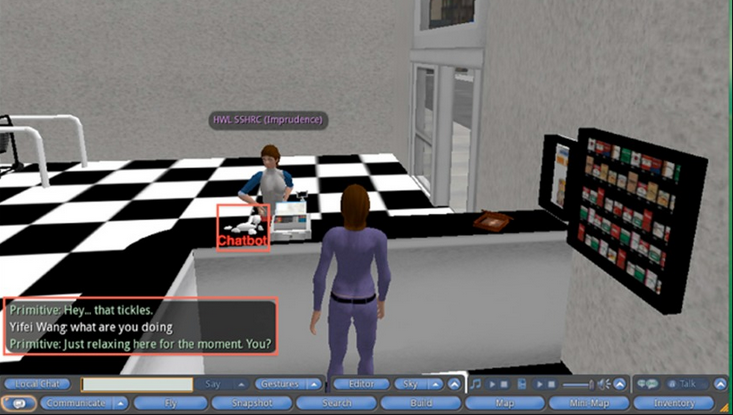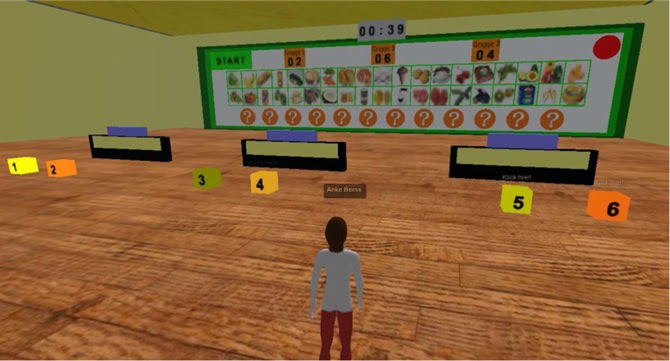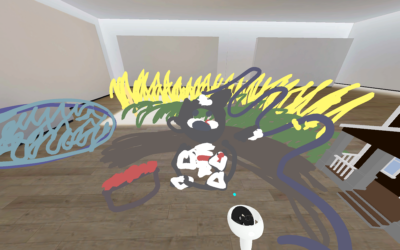Let’s imagine how XR could help us learn a new language: I put on my VR headset and can immediately connect to multiple virtual learning environments. As I browse through the options, I decide to transport myself to Paris for some virtual groceries with my AI assistant. While I take the metro, I listen to the conversations of the virtual inhabitants and as I leave the station, I bump into another French learner. We chat for a while and I become encouraged to practice even more. I decide to teleport myself to the virtual café where I can join virtual conversations with native French speakers.
In this article, we will give insight into the various ways in which XR technology can enrich and improve language learning and what needs to be focused on in order to achieve tangible learning outcomes.
Integration of XR into language courses
Studies have shown that learning performance of students tends to increase in active and blended learning environments [1]. This could be particularly true for language learners who are exposed to various modes of learning, ranging from theory and text-books to listening and speech exercises. The variety of exercises in language classrooms usually serves to immerse students in the language they’re trying to learn, in which different modes of immersion can exist. XR environments let students immerse themselves into a language, one step at a time. Students can move from guided conversations to a fully immersive experience of a foreign city that offers interactive modes of learning.
Given the structure of language courses, integrating XR experiences into an existing curriculum doesn’t pose a major challenge. For instance, role-playing exercises are already quite common. However, challenges can arise due to the students’ different levels of proficiency, their fear of speaking another language, and of course the physical limitations of classrooms or video calls.
Benefits of XR for language learning
There are multiple possible benefits of using XR for language learning.
Accessibility
Learning and mastering a new language is a process that benefits highly from an immersive experience. Repeated exposure to the target language, such as experienced during a study abroad trip, has been associated with successful language acquisition [2]. However, due to money and time constraints, these options are not available to all language learners. XR enables students to transport themselves to foreign language environments, which has already proven to be more effective than traditional methods in learning and remembering forerign words [2]. Virtual environments can be explored by students to contextualise objects in a meaningful way.
Kamedia’s Language Village represents a reproduction of a German city, where learners can complete learning tasks, interact with virtual characters and practice their target language through voice implementation.
From theory to practice
Language learning requires us to put theory into practice. XR learning environments can facilitate practical exercises by offering a wider range of scenarios that are more realistic, engaging and which allow learners to familiarise themselves with the sound of a language. By moving beyond simple classroom examples to applying their language skills in diverse contexts, students learn how to use language flexibly in different contexts. Chatbots have been used as virtual companions which can assist with language problems, providing real-time feedback while students explore a new city [3]. These gamified, goal-oriented interactions help to place the learned material into a more meaningful context and increase motivation [5]. Additionally, different levels of difficulty can cater towards specific learning stages.

VILLAGE (Virtual Immersive Language Learning and Gaming Environment)
Affective learning
Simulated environments can prepare language learners for real-life situations by taking away some of the stress associated with unfamiliar situations or practising a new language. They allow students to take risks, explore, and learn from their mistakes without the fear of receiving negative comments or criticism. In short, it creates a safe learning environment. One study involving students from Beijing Normal University showed that students using VR learning environments have been able to boost their self-confidence, reduce speaking anxiety and increase learning excitement [4]. Compared to other students who used a PC-based learning environment, students from the VR group performed better in terms of memory and language accuracy.
Social learning
Languages are social tools.Therefore, language programmes need to provide learners the opportunity to communicate with other language learners, or even better, native speakers of their target language. Traditional forms of communicating via text, calls, or meetups already offer many opportunities for learning how to express oneself in another language. XR is not merely able to transfer these traditional methods to a virtual platform, but also offers more interactive modes of cooperative learning. An example is through playful interactions, in which learners can challenge each other or have to work together in order to reach a certain goal [5]. Cooperation or competition help to motivate students while also stimulating them to learn from each other.

In this virtual space (built in Open Simulator), learners can team up and compete against each other to win challenges
XR as a supplementary tool
Learning a new language is a process that is still most successful, if learners are able to completely immerse themselves in the environment of their target language. However, students that are only exposed to their target language in classroom settings often fail to master it. In this context, XR becomes a tool that can offer meaningful experiences alongside traditional classroom settings.
How to continue
The use of XR in language classrooms is still limited to a couple of examples and study cases. These have given a great insight into what is possible with this technology and can help designers and educators to define how XR environments can support learning experiences. To create a learning-focused virtual environment with palpable learning outcomes, certain things need to be put into place:
- XR environments need to be integrated into real environments and traditional classroom settings: Although XR can help prepare students for real-life situations and ease speaking anxiety, students still need to adapt to using their target language in the real world.
- Exercises should be collaborative and encourage learners to interact with one another. Connecting learners with one another allows them to use their target language in more realistic scenarios and also gives students a motivational boost.
- Learning experiences should be directly related to learning goals [3]: By curating the simulated environments to students’ learning needs (e.g. business, culture or travel), the learning outcomes become much more measurable.
- The learning environments should encourage exploration, risk taking, and learning from mistakes: XR environments should strongly encourage students to actively use their target language in order to reduce their anxiety of speaking a new language.
In future language classrooms, XR could become an extremely useful tool that supports language learning by making immersion in the target language more accessible, introducing practical elements, and assisting in affective and social learning. The learning environments offered by XR are able to cater towards learners from all levels and guide them step by step, from learning new words all the way to handling complex social interactions in virtual environments.
PS – Be sure to read our article on Learning Abstract Concepts with XR as well, which is a great companion to this piece.
References
[1] https://journals.plos.org/plosone/article/file?id=10.1371/journal.pone.0148882&type=printable, https://www.pnas.org/content/111/23/8410
[2] https://www.mdpi.com/2226-471X/4/1/13
[3] https://bera-journals.onlinelibrary.wiley.com/doi/abs/10.1111/bjet.12388
[4] https://altairika.com/news/tpost/ou32ut58i9-vr-affects-memory-retention-on-language, https://skarredghost.com/2018/09/25/vive-immersive-labs-experiment-demonstrates-that-vr-can-really-help-in-learning-a-new-language/



